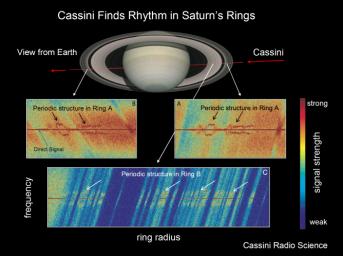
|
Saturn’s Ring Rhythm #2
- Click the image above for a larger view
- Full-Res JPEG (1808 x 1348) (270.3 kB)
- Full-Res TIFF (1808 x 1348) (7.3 MB)
Caption:
For an Earth observer on May 3, 2005, the Cassini spacecraft appeared to pass behind the rings, then Saturn, then the rings again (the red line). The discovered harmonic structure was found on both the way in and out, but only in locations where particles are densely packed together, such as the B ring and the innermost part of the A ring.
The May 3 radio experiment and several others to follow in 2005 showed that the regular spacing of the harmonic structure vary from 100 to 250 meters (320 to 820 feet), depending on the location in the rings. To see an illustration of this occultation see PIA10232 .
Background Info:
The Cassini-Huygens mission is a cooperative project of NASA, the European Space Agency and the Italian Space Agency. The Jet Propulsion Laboratory, a division of the California Institute of Technology in Pasadena, manages the mission for NASA's Science Mission Directorate, Washington, D.C. The Cassini orbiter was designed, developed and assembled at JPL. The radio science team is based at JPL.
For more information about the Cassini-Huygens mission visit http://saturn.jpl.nasa.gov/home/index.cfm . For more information on the radio science team visit http://saturn.jpl.nasa.gov/spacecraft/instruments-cassini-rss.cfm .
Cataloging Keywords:
| Name | Value | Additional Values |
|---|---|---|
| Target | Saturn Rings | B Ring, Saturn |
| System | Saturn | |
| Target Type | Ring | Planet |
| Mission | Cassini-Huygens | |
| Instrument Host | Cassini Orbiter | |
| Host Type | Orbiter | |
| Instrument | Radioscience Subsystem (RSS) | |
| Detector | ||
| Extra Keywords | Color, Disk, Occultation, Radio | |
| Acquisition Date | ||
| Release Date | 2008-01-31 | |
| Date in Caption | 2005-05-03 | |
| Image Credit | NASA/JPL | |
| Source | photojournal.jpl.nasa.gov/catalog/PIA10233 | |
| Identifier | PIA10233 | |
